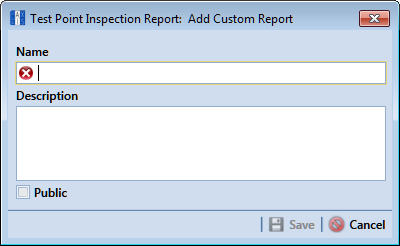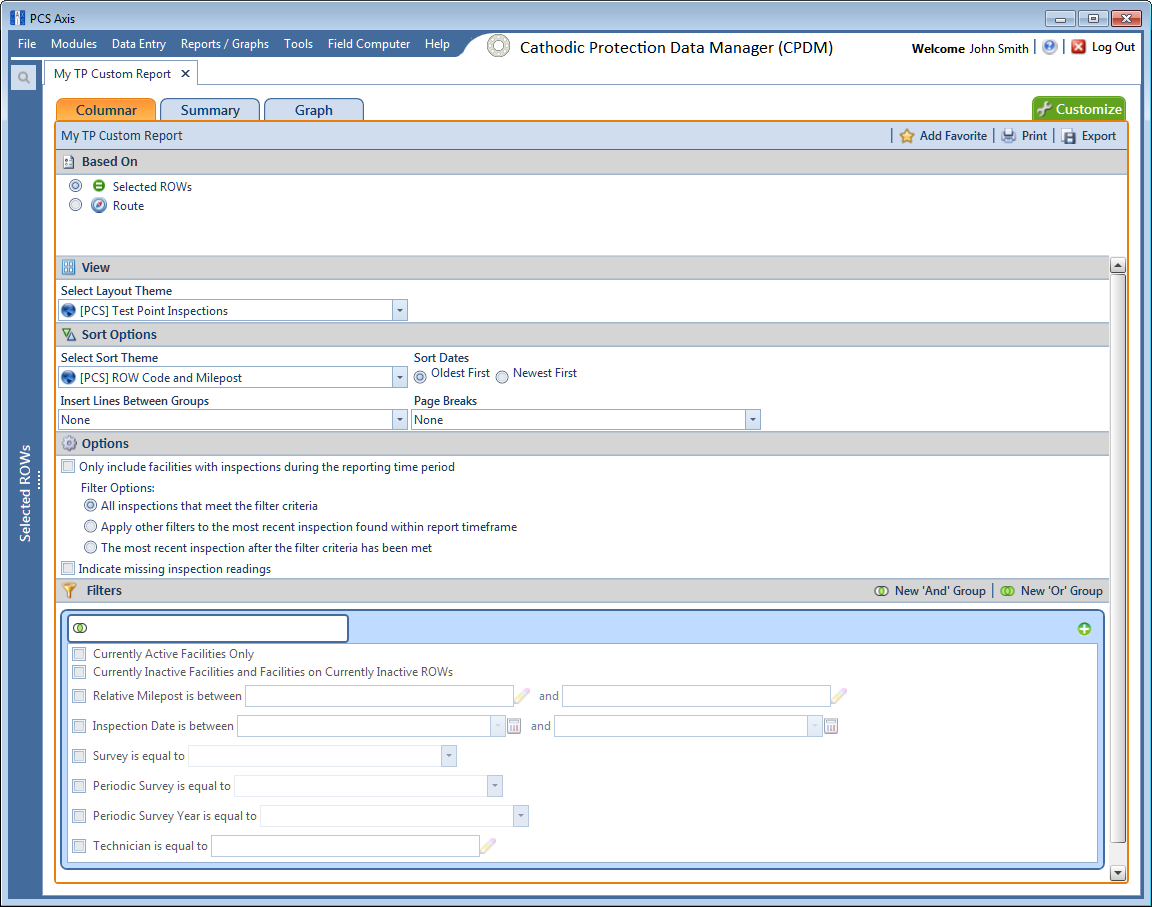Click Reports/Graphs, navigate to a report in the list, then click ![]() Add Report.
Add Report.
For example, click Reports/Graphs > Test Point Reports >Test Point Inspection Report > Add Report to open the Add Custom Report dialog box (Add Custom Report).

Type a name for the report in the Name field. This field is required.
If you want to add information about the report, type the information in the Description field.
Select the Public check box if you want the report available to all PCS users. When a report is not public, it is a private report that is only available to the user who created it.
Click ![]() Save.
Save.
When the report options window opens, select one of the following options to choose which facility records to include in the report:

-
Click the option Selected ROWs to include facilities associated with the pipeline selection(s) in the Select ROWs window.
-
Click the Route option and then select a route to include facilities associated with the selected route.
Click the down arrow in the Select Layout Theme field and choose a layout theme in the selection list. The layout theme determines which fields are included in the report.
For information about adding new report themes, such as a report layout theme, sorting theme, and filter theme, refer to Working with Report Themes and Filter Groups.
Complete the following steps in the Sort Options group box:
-
Click the down arrow in the Select Sort Theme field and choose a sorting theme in the selection list. The sorting theme determines how PCS sorts report data.
-
Choose a method for sorting inspection dates. Click Oldest First or Newest First in Sort Dates to sort records with the oldest or newest inspection dates first.
-
Choose an option for inserting a line between different groups of report data. Click the down arrow in the Insert Lines Between Groupsfield and choose an option in the selection list.
-
Choose an option that determines where a page break occurs in the report. Click the down arrow in the Page Breaks field and select an option in the selection list.
Select one or more of the following options as needed in the Options group box. Date range in filter criteria is determined by considering all time frame filters, such as inspection date, survey, and periodic survey filters.
-
Only show facilities with inspections: When time frame filters are not selected in the Filters group box, such as inspection date, survey, or periodic survey filters, the report includes all inspections using the inspection date and time as the reporting time period.
If one or more time frame filters are selected in the Filters group box, the report only includes inspections for the selected time frame filter(s).
-
All inspections that meet the filter criteria: Report includes all inspections that meet filter criteria based on selections in the Filters group box.
-
Apply other filters to the most recent inspection found within report timeframe: This option finds the latest inspection within the reporting time frame first, and then applies all other filters selected in the Filters group box. The report only includes inspections for facilities when the latest record within the date range meets other filters.
-
The most recent inspection after the filter criteria has been met: This option applies all filter criteria first based on selections in the Filters group box, and then finds the latest inspection.
-
Indicate missing inspection readings: This option includes an empty box in the report for each missing inspection reading.
Select optional filters in the Filters group box as required. For example, click Currently Active Facilities Only to include only currently active facilities in the report.
When adding a date filter, such as Inspection Date is between, set a date range using a calendar or dynamic dates in the following manner:
-
To set a date range using a calendar, click the down arrow in the start date field to open a calendar and select a date. Repeat this step for the end date field.
-
To set a date range using dynamic start and end dates, click the
 calculator button in the start date field and set up dynamic date properties. Repeat this step for the end date field. Clicking the calculator button opens and closes dynamic date property fields.
calculator button in the start date field and set up dynamic date properties. Repeat this step for the end date field. Clicking the calculator button opens and closes dynamic date property fields.
If you want to add the report in Favorite Reports, click ![]() Add Favorite.
Add Favorite.
If you want to remove a favorite report listed in Favorite Reports, open the report and then click ![]() Remove Favorite in the report options window.
Remove Favorite in the report options window.
To print the report:
-
Click
 Print to open the report in a preview window.
Print to open the report in a preview window. -
To print the report using the default printer set up in Windows, click the
 Quick Print button. To select a printer other than the default printer, click the
Quick Print button. To select a printer other than the default printer, click the  Print button.
Print button.